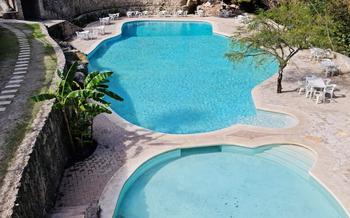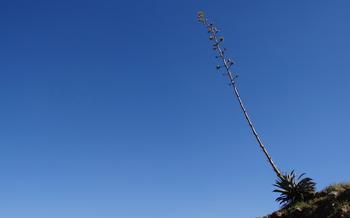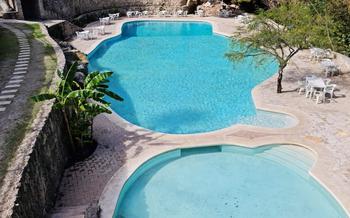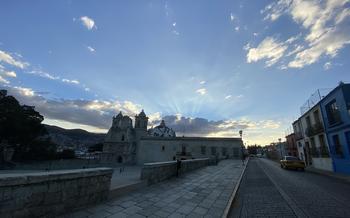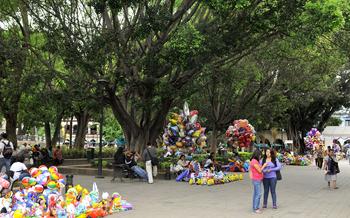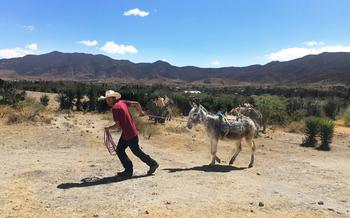
Yaxe Archaeological Site
- A Zapotec City in the Clouds
- Treasures of Ancient Zapotec Art
- Yaxe's Contribution to Zapotec Astronomy
- Pilgrimage to the Sacred Mountain
- Hiking Trails and Natural Wonders
- Community Engagement and Local Culture
- Unveiling the Secrets of the Zapotec Ball Game
- A Haven for Birdwatchers and Nature Lovers
- The Legacy of Zapotec Engineering
- Interactive Museum and Cultural Center
- Local Cuisine and Culinary Delights
- Festivals and Cultural Events
- Sustainable Tourism Practices
- Insider Tip:
A Zapotec City in the Clouds
Yaxe, nestled high in the Sierra Madre mountains of Oaxaca, Mexico, was a prominent pre-Hispanic Zapotec city that flourished from around 500 BC to 900 AD. Its strategic location, atop a mountain overlooking the Tlacolula Valley, provided a natural fortress and afforded breathtaking views of the surrounding landscapes. Yaxe played a crucial role in the Zapotec civilization, serving as a significant political, economic, and religious center. Its proximity to the powerful city of Monte Albán, the Zapotec capital, suggests a close relationship and interaction between the two cities. Yaxe's rich cultural heritage and traditions left an indelible mark on the region, shaping the identity and customs of the Zapotec people.
Treasures of Ancient Zapotec Art
Yaxe reveals itself as a treasure trove of elaborate stone carvings that captivate visitors with their intricate depictions of Zapotec mythology, history, and rituals. These carvings tell stories of gods, heroes, and everyday life, offering a glimpse into the rich cultural tapestry of the Zapotec civilization.
Notable among these carvings are the Yaxe stelae, large stone slabs adorned with intricate glyphs and images. These stelae provide valuable insights into Zapotec writing and calendrical systems, helping scholars decipher the complex language and chronology of the Zapotec civilization.
In addition to stone carvings, Yaxe boasts a wealth of ceramic artifacts that shed light on Zapotec customs and economy. Ceramic vessels, figurines, and other objects provide clues about daily life, trade networks, and artistic traditions of the Zapotec people.
The artistic and cultural value of Yaxe's artifacts extends beyond their historical significance. These objects showcase the remarkable creativity and craftsmanship of the Zapotec artisans, demonstrating their mastery of various techniques and materials.
Through these artistic treasures, Yaxe unveils the vibrant cultural heritage of the Zapotec civilization, inviting visitors to delve into the depths of their rich mythology, history, and artistic traditions.
Yaxe's Contribution to Zapotec Astronomy
The Zapotecs were skilled astronomers, and Yaxe played a significant role in their understanding of celestial phenomena. The site features unique astronomical alignments that demonstrate the Zapotecs' knowledge of the stars, planets, and their movements. These alignments were likely used for religious purposes, as the Zapotecs believed that the cosmos held great power and influence over their lives.
One of the most striking astronomical features at Yaxe is the alignment of the main temple with the rising sun on the summer solstice. This alignment suggests that the Zapotecs used the temple as an observatory to mark the start of the agricultural season. Other alignments at Yaxe correspond with significant celestial events, such as the equinoxes and the transit of Venus.
The Zapotecs also incorporated astronomical knowledge into their city planning and construction. The orientation of the main plaza and the placement of buildings were carefully designed to align with celestial bodies and events. This integration of astronomy into architecture demonstrates the importance of the cosmos to Zapotec culture and their sophisticated understanding of the universe.
Studying Yaxe's astronomical knowledge is crucial for deciphering Zapotec beliefs and rituals. By unraveling the mysteries of their celestial alignments, we gain insights into their religious practices, cosmology, and their worldview. Yaxe stands as a testament to the Zapotecs' remarkable achievements in astronomy and their deep connection to the cosmos.
Pilgrimage to the Sacred Mountain
Yaxe held a profound spiritual significance for the Zapotec people, serving as a sacred pilgrimage site. The mountaintop temple was a place of worship and offerings to Zapotec deities, drawing pilgrims from across the region. These pilgrimages were imbued with religious fervor and a deep sense of reverence.
During these pilgrimages, Zapotec people would ascend the sacred mountain, often barefoot, as a symbol of humility and devotion. They carried offerings to present to their deities, seeking blessings, protection, and guidance. The journey itself was considered a sacred act, a physical manifestation of their spiritual connection to the divine.
Upon reaching the temple, pilgrims would engage in various rituals and ceremonies, offering prayers, burning incense, and leaving behind their offerings. They sought divine favor, petitioned for healing or guidance, and expressed their gratitude for the blessings they had received.
The act of pilgrimage to Yaxe was not merely a religious duty but a transformative experience. It strengthened the bonds between the Zapotec people and their deities, fostering a sense of community and shared spirituality. Even today, Yaxe continues to hold a special place in the hearts of Zapotec people, serving as a reminder of their rich cultural and religious heritage.
Hiking Trails and Natural Wonders
Beyond the archaeological treasures of Yaxe, the surrounding environment offers a sanctuary of natural wonders and scenic hiking trails. Embark on a journey through the picturesque mountains and lush forests that envelop the ancient city. Discover a diverse tapestry of flora and fauna, including endemic species and vibrant birdlife that flutter through the canopies. As you ascend the winding paths, breathtaking viewpoints unveil panoramic vistas of the valley and the distant landscapes, painting a mesmerizing tableau of nature's splendor. Whether you're an avid hiker or simply seeking tranquility amidst nature's embrace, Yaxe's natural surroundings promise an enriching experience that complements the exploration of its ancient heritage.
Community Engagement and Local Culture
The local community plays a crucial role in preserving and promoting Yaxe's cultural heritage. Visitors to the site have the opportunity to engage with Zapotec artisans, learn about traditional crafts, and support local initiatives. Artisans demonstrate their skills in weaving, pottery, and wood carving, offering insights into the rich cultural traditions of the region. Visitors can purchase handmade souvenirs and support the livelihoods of local craftspeople, contributing to the sustainability of the community. It is important to respect and understand Zapotec customs and traditions while visiting the site. Visitors should dress modestly, ask permission before taking photographs, and avoid disturbing ongoing ceremonies or rituals. Community-based tourism initiatives promote sustainable development and cultural preservation, ensuring that the benefits of tourism are shared with the local population.
Unveiling the Secrets of the Zapotec Ball Game
The ball game held a sacred and significant place in Zapotec culture, deeply intertwined with religious rituals and social events. Played on a specially designed ball court—a prominent feature of Yaxe—the game involved two teams using their hips and arms to keep a solid rubber ball in play. Victory in the game symbolized triumph over adversaries and divine favor.
The Yaxe ball court, with its distinctive sloping sides and stone markers, provides valuable insights into the rules and gameplay. Archaeologists believe that the game involved hitting the ball against the markers or through designated hoops, with the objective of scoring points. The outcome of the game was not merely a matter of physical skill but also had spiritual implications, often associated with fertility, warfare, and divine favor.
However, the exact rules and rituals surrounding the Zapotec ball game remain a subject of debate among scholars. Some theories suggest that the game may have been played with two opposing teams, while others propose a more complex system involving multiple teams and intricate rules. The significance of the ball game extended beyond the physical contest; it served as a symbolic representation of the cosmos, with the ball representing the sun or the moon, and the court representing the earth.
The legacy of the Zapotec ball game continues to captivate researchers and visitors alike. As archaeologists delve deeper into the mysteries of Yaxe and other archaeological sites, we gain a richer understanding of this ancient ritual and its profound impact on Zapotec culture and society.
A Haven for Birdwatchers and Nature Lovers
Yaxe's diverse ecosystem provides a haven for a wide range of bird species, making it a paradise for birdwatchers and nature enthusiasts. The surrounding forests and wetlands are home to both migratory and endemic birds, offering a unique opportunity to observe and photograph these magnificent creatures in their natural habitat. Some of the commonly spotted species include the Montezuma Oropendola, the Rufous-capped Warbler, and the White-throated Jay. The Yaxe region is also an important stopover point for migratory birds, such as the Swainson's Hawk and the Broad-winged Hawk, making it an ideal location for birdwatching during the spring and fall migrations.
When visiting Yaxe, be sure to bring your binoculars and a camera to capture the beauty of the local birdlife. Remember to practice responsible birding practices by minimizing disturbance to the birds and their habitat. Avoid loud noises, stay on designated trails, and refrain from littering. By following these guidelines, you can help protect the delicate ecosystem and ensure that future generations can enjoy the wonders of Yaxe's birdlife.
The Legacy of Zapotec Engineering
The ancient Zapotecs at Yaxe demonstrated remarkable engineering skills in constructing sophisticated water management systems. To combat the challenges of a semi-arid climate, they built an intricate network of terraces, canals, and reservoirs, harnessing and distributing water for agricultural purposes. These systems allowed them to cultivate crops, sustain their population, and establish a flourishing city in an otherwise challenging environment.
The Zapotecs' expertise in water management is evident in the well-preserved terraces that line the hillsides of Yaxe. These stone-faced structures helped to prevent erosion, conserve soil, and channel water runoff into reservoirs. The canals, constructed with precision, facilitated the efficient distribution of water throughout the city, ensuring a reliable supply for both domestic use and irrigation.
Their ingenuity extended to the construction of reservoirs, which collected and stored rainwater during the wet season. These reservoirs served as a vital source of water during the dry spells, allowing the Zapotecs to maintain a consistent water supply throughout the year. The Zapotec engineers' ability to manage water resources effectively was crucial to the city's survival and prosperity, showcasing their advanced understanding of hydrology and sustainable agricultural practices.
Interactive Museum and Cultural Center
Yaxe's cultural significance is further enhanced by the establishment of a modern museum and cultural center dedicated to showcasing its rich history and legacy. This state-of-the-art facility serves as a repository of knowledge and a platform for disseminating information about Zapotec culture, archaeology, and daily life.
Through engaging exhibits, interactive displays, and educational programs, the museum provides visitors with an immersive and comprehensive understanding of Yaxe's past. Artifacts, replicas, and multimedia presentations bring to life the stories of the Zapotec people, their traditions, and their remarkable achievements.
The cultural center also hosts workshops, lectures, and demonstrations that allow visitors to delve deeper into Zapotec culture. Local artisans showcase their skills in traditional crafts, such as weaving, pottery, and woodworking, providing visitors with a hands-on experience and an appreciation for Zapotec artistry.
By establishing this museum and cultural center, Yaxe is not only preserving its heritage but also ensuring that it remains a vibrant and dynamic part of contemporary Zapotec identity. Visitors to Yaxe are encouraged to visit this exceptional facility to gain a deeper understanding of the Zapotec civilization and its enduring legacy.
Local Cuisine and Culinary Delights
The Oaxaca region boasts a rich culinary heritage deeply rooted in its indigenous Zapotec traditions. Visitors to Yaxe have the opportunity to savor authentic Zapotec dishes prepared with fresh, local ingredients.
Zapotec cuisine is known for its vibrant flavors, diverse textures, and unique combinations of ingredients. Common dishes include tlayudas, large, crispy tortillas topped with beans, cheese, meat, and vegetables; tamales, steamed corn cakes filled with savory fillings; and mole, a complex sauce made with various chiles, spices, and often chocolate.
To fully immerse yourself in the local culinary experience, visit the Mercado Benito Juárez, a bustling market in the heart of Oaxaca City. Here, you can sample a variety of street food stalls, purchase fresh produce and ingredients, and interact with local vendors.
For a fine-dining experience, try one of the many restaurants in Oaxaca City that specialize in Oaxacan cuisine. These establishments offer a sophisticated take on traditional dishes, often using modern techniques and locally sourced ingredients.
To support the local community and preserve culinary heritage, make an effort to dine at locally owned restaurants and markets. Ask your hotel concierge or a local guide for recommendations.
Recommended dishes to try:
- Tlayudas: Large, crispy tortillas topped with beans, cheese, meat, and vegetables.
- Tamales: Steamed corn cakes filled with savory fillings, such as chicken, pork, or vegetables.
- Mole: A complex sauce made with various chiles, spices, and often chocolate, served with meat or vegetables.
- Quesillo: A stringy, white cheese often used in tlayudas and other dishes.
- Chapulines: Toasted grasshoppers, considered a delicacy in Oaxaca.
Festivals and Cultural Events
The Oaxaca region is renowned for its vibrant festivals and cultural events that celebrate Zapotec traditions and cultural expressions. These events provide an immersive experience for visitors to witness the rich heritage of the region. The Guelaguetza, held annually in July, is one of the most famous festivals, showcasing traditional dances, music, and colorful costumes from different regions of Oaxaca. The Day of the Dead (Dia de los Muertos) in November is another significant festival, where families honor their deceased loved ones with colorful altars, parades, and festivities. Visitors can participate in traditional dances, enjoy live music performances, and savor delicious local cuisine during these events. To fully experience the cultural essence of the region, it is recommended to plan a trip to coincide with one of these festivals.
Sustainable Tourism Practices
When visiting Yaxe, it's crucial to practice responsible tourism to minimize environmental impact and preserve the site for future generations. Respect the local community by asking permission before entering private property and adhering to local customs. Reduce waste by bringing reusable water bottles and containers, and dispose of trash properly. Conserve water by taking shorter showers and avoiding unnecessary water usage. Support sustainable initiatives by choosing locally-owned businesses, using public transportation, and participating in conservation efforts. By embracing responsible tourism practices, you can help protect Yaxe's natural and cultural heritage while ensuring its preservation for years to come.
Insider Tip:
For an unforgettable experience, plan your visit to Yaxe during the dry season, typically from November to April, when the weather is at its best. To avoid the crowds and have a more intimate encounter with the site, consider visiting on a weekday or early in the morning. Don't miss the opportunity to explore the surrounding area, where hidden gems like the ancient Zapotec village of Yagul and the stunning landscapes of the Sierra Norte await. To delve deeper into Yaxe's history and culture, engage the services of a local guide or tour operator who can provide expert insights and anecdotes. Finally, remember to bring your camera to capture the breathtaking beauty of the site and its surroundings, creating lasting memories of your journey to Yaxe.

